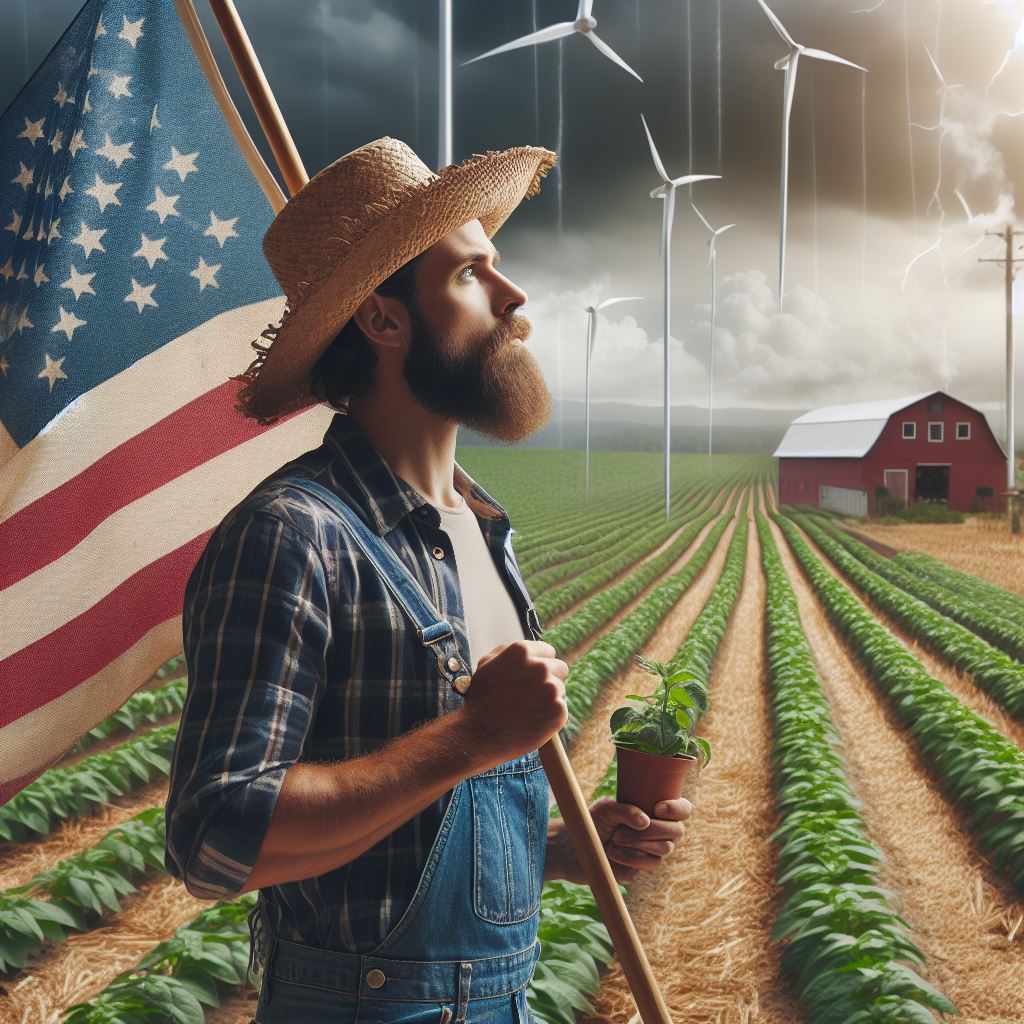Introduction
Permaculture is a sustainable farming method that focuses on designing ecological systems to mimic natural patterns.
By employing permaculture practices, farmers can reduce their environmental impact and enhance biodiversity.
This approach promotes sustainable food production, water conservation, and soil regeneration.
Permaculture also empowers farmers to create self-sufficient ecosystems that require minimal external inputs.
The role of permaculture in the sustainable farming revolution is crucial.
It provides a holistic approach to farming that aims to work in harmony with nature.
By integrating elements such as agroforestry, composting, and rainwater harvesting, permaculture offers sustainable solutions.
Permaculture farms maximize productivity while minimizing the use of synthetic fertilizers and pesticides.
It is a long-term solution that addresses the challenges of climate change and the depletion of natural resources.
In fact, permaculture is revolutionizing sustainable farming practices by offering a holistic and regenerative approach.
By embracing permaculture, farmers can create resilient agricultural systems that benefit both the environment and society.
It is a path towards a more sustainable and ethical future of food production.
What is Permaculture
Permaculture is a holistic approach to sustainable farming and living that offers practical solutions for a regenerative future.
By understanding its origins, principles, and key components, we can gain a deeper appreciation for permaculture’s potential.
Definition and origins of permaculture
Permaculture has its roots in Australia, where Bill Mollison and David Holmgren developed the concept in the 1970s.
Combining “permanent agriculture” and “permanent culture,” permaculture emerged as a response to the environmental and social challenges of the time.
Principles and ethics guiding permaculture design
At its core, permaculture is guided by three ethics: care for the earth, care for people, and fair share.
These ethics inform the principles of permaculture design, which include observing and interacting with nature, using renewable resources, and integrating elements into functional relationships.
Transform Your Agribusiness
Unlock your farm's potential with expert advice tailored to your needs. Get actionable steps that drive real results.
Get StartedKey components of permaculture systems
Permaculture systems involve a range of components that work together synergistically.
Food forests, or edible landscapes, are a central feature of permaculture design.
These multi-layered systems mimic natural forests and provide abundant, diverse sources of food.
Water management is another crucial aspect of permaculture.
Techniques such as swales, ponds, and rainwater harvesting help to capture and store water, reducing reliance on external sources and preventing erosion.
Building healthy soil is a fundamental part of permaculture.
Composting, mulching, and cover cropping are practices used to enhance soil fertility and structure.
This promotes plant health and resilience, reducing the need for synthetic inputs.
Animals play a significant role in permaculture systems.
Livestock can be integrated into the design to provide manure for compost, control pests, and contribute to overall system health.
Beneficial insects also play a vital role in biological pest control.
Energy efficiency and renewable energy sources are central to permaculture design.
Designing buildings to maximize natural light, utilizing renewable energy technologies such as solar panels, and minimizing energy consumption are all part of creating sustainable systems.
Beyond the physical aspects, permaculture recognizes the importance of social and community elements.
Building resilient communities, sharing surplus resources, and promoting social equity are fundamental principles of permaculture.
In short, permaculture offers a holistic and sustainable approach to farming and living.
By understanding its definition, origins, principles, and key components, we can embrace permaculture as a revolutionary way to create regenerative and resilient environments for future generations.
Read: Climate Resilient Livestock Farming
Benefits of Permaculture
Permaculture offers numerous benefits that prove its importance and effectiveness in sustainable farming practices.
The advantages can be categorized into environmental, social, and economic benefits.
Environmental Benefits
Permaculture focuses on soil regeneration and erosion control by employing practices that replenish and restore the soil.
Through methods such as cover cropping, mulching, and using organic matter, permaculture enhances soil health, preventing erosion and nutrient depletion.
One of the significant advantages of permaculture is biodiversity conservation.
By emulating natural ecosystems, permaculture systems create a diverse habitat that supports various plant and animal species.
This fosters biodiversity conservation, safeguarding the balance and resilience of the ecosystem.
Water management and conservation are crucial aspects of permaculture.
The design and implementation of water catchment systems, such as rainwater harvesting and swales, help minimize water wastage.
These methods ensure efficient water usage, reducing the strain on local water resources.
Social and Economic Benefits
Permaculture plays a vital role in promoting local food production and self-sufficiency.
By encouraging individuals and communities to grow their own food, permaculture reduces reliance on global industrial agriculture.
This not only ensures access to fresh and nutritious produce but also fosters food security and resilience in the face of food crises.
Community engagement and empowerment are fundamental elements of permaculture.
Through collaborative efforts, knowledge sharing, and collective decision-making, permaculture brings communities together.
It strengthens social bonds, increases self-reliance, and empowers individuals to take an active role in shaping their local food systems.
Economic viability and resilience are enhanced by adopting permaculture principles.
By diversifying income streams and implementing sustainable farming practices, permaculture systems provide economic stability.
This diversity also allows farmers to adapt to changing market conditions, reducing vulnerability and enhancing overall resilience.
In general, permaculture offers a wide range of benefits.
From environmental advantages like soil regeneration, biodiversity conservation, and water management, to social benefits such as local food production, community engagement, and empowerment, and finally economic benefits like enhanced viability and resilience.
Permaculture is a sustainable farming revolution that addresses the pressing challenges of our time while cultivating harmony with nature and promoting resilient communities.
Read: Cover Crops: Climate Warriors
Permaculture Techniques and Design Principles
Agroforestry and forest farming
Agroforestry combines trees, crops, and livestock to create sustainable and diverse agricultural systems.
Forest farming involves growing crops under the canopy of existing forest ecosystems.
Polyculture and companion planting
Polyculture promotes the cultivation of multiple crops in the same area, increasing biodiversity and resilience.
Companion planting involves growing plants together that benefit each other, such as repelling pests or supporting growth.
Swales and earthworks for water management
Swales are shallow ditches that capture and hold water, preventing erosion and improving soil moisture.
Earthworks, such as ponds and terraces, help manage water by slowing its flow and allowing it to infiltrate into the ground.
Composting and waste management
Composting converts organic waste into nutrient-rich soil amendments, reducing the need for chemical fertilizers.
Effective waste management ensures the proper handling and utilization of waste materials in a sustainable manner.
Animal integration and rotational grazing
Animal integration involves integrating livestock into crop and land management systems, creating symbiotic relationships.
Rotational grazing involves moving livestock through different grazing areas, allowing plants to regenerate and improving soil health.
Keyline design and contouring
Keyline design uses contours and slopes to direct water flow, preventing erosion and maximizing water infiltration.
Contouring involves shaping land to follow its natural contours, reducing water runoff and increasing water retention.
Energy-efficient and regenerative building design
Energy-efficient building design focuses on minimizing energy consumption and using sustainable materials.
Regenerative building design aims to restore and enhance natural systems through the construction and operation of buildings.
Showcase Your Farming Business
Publish your professional farming services profile on our blog for a one-time fee of $200 and reach a dedicated audience of farmers and agribusiness owners.
Publish Your ProfilePermaculture techniques and design principles provide a framework for sustainable farming practices.
By implementing these strategies, farmers can create resilient and productive systems that work in harmony with nature.
Agroforestry and forest farming integrate various elements, combining trees, crops, and livestock to maximize efficiency and diversity on the farm.
Polyculture and companion planting promote biodiversity and minimize the risk of crop failures by cultivating different crops together.
This reduces pests and diseases, enhances soil fertility, and increases overall farm resilience.
Additionally, swales and earthworks help manage water effectively, preventing erosion and optimizing water availability for crops.
Composting and waste management are essential for reducing organic waste and transforming it into valuable soil amendments.
By reusing and recycling resources, farmers can minimize inputs and promote natural nutrient cycles.
Animal integration and rotational grazing further enhance sustainability, as livestock can contribute to nutrient cycling and soil improvement.
Keyline design and contouring techniques focus on water management, preventing erosion and enhancing soil moisture retention.
By shaping land according to its natural contours, farmers can optimize water infiltration and reduce runoff.
Lastly, energy-efficient and regenerative building design techniques ensure that farm infrastructures are sustainable and environmentally friendly.
In a nutshell, permaculture techniques and design principles offer practical and effective solutions for sustainable farming.
By adopting these practices, farmers can create productive, resilient, and environmentally conscious agricultural systems that support both people and the planet.
Read: Renewable Energy in Agriculture

Examples of Successful Permaculture Projects
Small-scale urban permaculture gardens
- In cities around the world, individuals are transforming small spaces into productive permaculture gardens.
- These gardens utilize vertical gardening techniques and maximize space to grow a variety of vegetables and fruits.
- Urban permaculture gardens reduce reliance on imported produce and provide fresh, organic food to residents.
- Many cities have community programs where residents can rent small plots of land to grow their own food.
- These small-scale urban permaculture gardens also create green spaces in otherwise concrete-laden areas.
Community-supported agriculture initiatives
- Community-supported agriculture (CSA) initiatives have gained popularity in recent years.
- These initiatives connect local farmers with consumers in a mutually beneficial arrangement.
- Consumers pay a subscription fee to receive a weekly share of the produce grown on the permaculture farms.
- By participating in CSAs, consumers support local agriculture and receive fresh, organic, and seasonal food.
- Permaculture farms that engage in community-supported agriculture initiatives often prioritize regenerative farming practices.
Permaculture farms and homesteads
- Permaculture farms and homesteads are larger-scale projects that employ permaculture principles across vast areas.
- These farms aim to create self-sustaining ecosystems where each element supports and benefits others.
- Permaculture farms often integrate livestock, crop rotations, and water management systems to maximize efficiency.
- Some permaculture farms have successfully regenerated degraded land and restored biodiversity.
- By implementing permaculture techniques, these farms minimize the use of synthetic inputs and focus on regenerative practices.
Permaculture education centers and demonstration sites
- Permaculture education centers and demonstration sites serve as educational hubs for sustainable farming practices.
- These sites offer workshops, courses, and hands-on training on permaculture principles and techniques.
- They showcase successful permaculture designs, providing inspiration and knowledge to aspiring practitioners.
- Permaculture education centers often collaborate with local communities, schools, and organizations to spread awareness.
- These centers demonstrate the potential of permaculture to address environmental, social, and economic challenges.
Overall, these examples of successful permaculture projects demonstrate the diverse applications and benefits of adopting permaculture principles.
From small-scale urban gardens to larger permaculture farms and education centers, these initiatives contribute to sustainable food production, community empowerment, and environmental regeneration.
By embracing permaculture, individuals and communities can create resilient and regenerative systems that prioritize the health of the planet and its inhabitants.
Read: Greenhouse Tech: Farming’s Answer to Climate Shift
Challenges and Limitations of Permaculture
Initial investment and labor-intensive nature
- Permaculture requires a significant initial investment, including land, tools, and materials.
- Implementing permaculture principles often involves manual labor, making it a time-intensive process.
- This can deter farmers who may not have the resources or manpower to commit to such endeavors.
Limited scalability for large-scale commercial agriculture
- Permaculture is designed to be small-scale and focused on local and sustainable production.
- It may not be feasible or efficient for large-scale commercial agriculture operations.
- The intricate design and specific management techniques required can make scaling up a challenge.
Climate and geographical constraints
- Permaculture practices may have limitations in certain climates or geographical regions.
- Some permaculture methods rely on specific environmental conditions, such as temperature or rainfall.
- This can limit the applicability and effectiveness of permaculture in certain areas.
Knowledge and skill barriers
- Successfully implementing permaculture requires knowledge and skills in ecological design and management.
- Farmers may need to acquire training and education to effectively apply permaculture principles.
- This can be a barrier for those without access to such resources or with limited agricultural knowledge.
Despite these challenges and limitations, permaculture offers numerous benefits and opportunities.
It is important to understand and address these obstacles to further promote sustainable farming practices.
Efforts should be made to make permaculture more accessible and adaptable to different contexts.
Training programs, educational initiatives, and financial support can help overcome the barriers faced by farmers.
Research and innovation are also key to finding solutions to scalability and geographical constraints.
Collaboration between farmers, scientists, and policymakers is crucial to advancing permaculture as a sustainable farming revolution.
By recognizing and addressing these challenges, we can work towards a more resilient and sustainable agricultural system.
Conclusion
Recap of the role of permaculture in the sustainable farming revolution
Permaculture has proven to be a game-changer in the sustainable farming revolution.
By implementing permaculture principles and practices, farmers have been able to create efficient, regenerative, and self-sustaining agricultural systems.
Permaculture emphasizes the importance of working with nature, rather than against it, to achieve long-term sustainability.
Encouragement for further exploration and adoption of permaculture
It is crucial for individuals and communities to continue exploring and adopting permaculture in their farming practices.
The benefits of permaculture extend beyond sustainability and include increased biodiversity, improved soil health, and reduced reliance on synthetic inputs.
By embracing permaculture, we can create a better future for ourselves and the planet.
Call to action for individuals, communities, and policymakers to support and promote permaculture initiatives
We must actively support and promote permaculture initiatives at all levels.
Individuals can start by educating themselves about permaculture and implementing its principles in their own gardens or farms.
Communities can organize workshops, share resources, and establish permaculture demonstration sites.
Policymakers need to recognize the value of permaculture and provide incentives for farmers to adopt sustainable practices.
By working together, we can create a widespread shift towards permaculture and build a more sustainable, resilient, and prosperous agricultural future.




